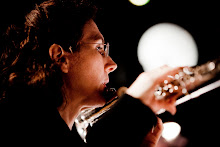This entry is cross posted on the musikFabrik blog
This video gives a brief demonstration of some common air sounds and percussive effects on the flute.
For players, when doing air sounds, it is not always necessary to use as much air as possible. After a long, loud passage, you might find yourself passed out on the floor! The trick here is to make as sibilant a sound as possible. One way of doing this is to actually narrow the throat a little to make the air passage smaller (I know, just the opposite of what we all learned!), then raise the tongue a little, so that it disturbs the distribution of air wanting to escape from your mouth. These are subtle adjustments, you needn’t do too much. All you are doing is speeding up the air, as when you narrow the end of a garden hose to make it spray further. For loud passages, you will still need to give extra support from down below, putting your abdominal muscles into play.
The pizzicati sounds will be louder and more resonant if the flute is turned out a bit. The more you can make resonance in your own mouth, the better. For maximum resonance for key clicks, stay in playing position, open your throat as far as possible, and open your mouth just a bit more over the embouchure hole to create an extra resonance chamber.
I have posted some further information on the production of tongue pizzicato here.
For composers:
There is unfortunately no standarisation of notation for these effects. I have shown on the video those recommended by Pierre-Yves Artaud in his book Present Day Flutes. I find these to be quite intuitive, but maybe another flutist will have another opinion.
When notating air sounds for the flute, please avoid using empty note heads, unless an empty note head is rhythmically called for (a half note, dotted half note, or whole note). I know, Helmut Lachenmann, Isabel Mundry, and other well-known composers use open note heads, but it makes their music extremely frustrating to read. I am hoping that this tradition will die out. (For more about this and to see written musical examples, read my blog entry here.)
Key clicks on the flute fall into my “Why Bother?” category. Unless you carefully compose them in a solo work, or under amplification, you won’t hear them. 95 % of the time, I end up having to reinforce them with a tongue pizz. Helmut Lachenmann’s Mouvement is an exception, there are some passages with pure key clicks that can actually be heard! However, other passages in that piece that need the reinforcement of a tongue pizz.
Note that the difference between a tongue pizz produced on the palate and a tongue pizz produced on the lips is not very distinct. It may be best to let the player decide where to produce the pizz. Some can do it on the palate better, others more effectively on the lips. However there are circumstances, such as close amplification, where that small difference can be quite interesting.
Now, if only I could beatbox…..


Nice video, Helen! And good advice about keeping the flute in playing position for key clicks - not only does this allow you to create an additional resonance in your mouth, but it will also ensure that the clicks are at (approximately) the correct pitch! Removing the flute from the playing position will completely free the mouthhole (otherwise slightly covered) and thus change intonation, making the clicks almost up to 1/4th of a tone higher than the played pitch…
ReplyDeleteThanks Claudio, that's a very good point! I also forgot to mention that one can do key clicks with the embouchure hole completely covered. This will lower the pitch a major 7th. This is also the case with the tongue ram. The sounding pitch is a major 7th below that of the fingered pitch.
ReplyDeletegreat !
ReplyDelete